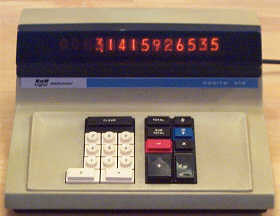

| +Home | Museum | Wanted | Specs | Previous | Next |
SCM Cogito 414 Desktop Calculator
Updated 11/3/2023
The SCM (Smith Corona Marchant) Cogito 414 is the first calculator offered by SCM to be implemented fully with large-scale integration (LSI) Metal-Oxide Semiconductor (MOS) integrated circuits. Shortly after the 414 was introduced on April 23, 1968, a virtually identical calculator, the Cogito 412 was introduced, with the sole difference being in the number of digits of capacity -- 14 for the Cogito 414, and, twelve for the Cogito 412. In terms of function and operation, the machines are identical. The same main circuit board is used in both machines, though different IC's are used in the 414 versus the 412 due to the extra two digits of capacity on the 414. An article in the New York Times dated April 24, 1969, announces the Cogito 414, touting its use of Large Scale IC technology as enabling it to be the smallest machine on the market with full calculator functionality.
A Look at the Display Board & Driver Circuitry It is estimated that the exhibited Cogito 414 was
built in the early 1970 time frame, with date codes all but one of the IC's in
late-1969, and a single IC with a 1972 date code . The IC with the '72 date code is suspected
to be a service replacement, since all of the other IC's as well as a few other components
are dated in mid-to-late 1969. In cases where there is a single or a few outliers in the date codes,
it's fairly safe to assume that date code range of the earliest ICs in the machine give the closest
base upon which a build date can be extrapolated. In the exhibited Cogito 414, the IC with the 1972
date code is located on the main board. All of the IC's on the main board are plugged into Molex-style
sockets, so the chips are easily replaced without any evidence left of the replacement. Soldered-in
chips leave signs of manual soldering of a replacement chip which can be solid give-away that a
device has been replaced. IC's installed in sockets don't leave such traces of replacement.
SCM Cogito 414 Internal View Cogito 412/414 Keyboard Detail Internally the 414 differs a bit from
the 412. The 412 uses two daughter boards, each with two LSI IC's soldered
onto them which plug into edge card connectors on the main board. The Cogito 414
combines the two daughter boards into one, with four LSI's on it, but the IC's on the
414's daughter board are different than those on the 412. It is suspected that the
IC's on the motherboard provide the core functions of the machine, including the timing chip,
the adder, the data routing chip, and the register chip. These ICs are universal
in function, and are common functions in virtually any electronic calculator, thus
they are easily shared between models of calculators with varying features and functions. This
allows the main board to be used in different models of calculator, while
the daughter board(s) contain the ICs that vary between models, giving
them their individualized functionality. These plug-in boards would be home for
the ROM chips, the display chip, and the keyboard chip. This is just a theory, but
it would make sense from the standpoint of providing economy of scale by providing
for use of the motherboard in different models of calculator, with the plug-in board(s)
providing the unique functionality/feature aspects of the specific models. This is further substantiated
by the fact that the chips on the motherboard have the same part numbers in the Cogito 412 and
Cogoto 414, while the daughter card ICs have different part numbers.
Back View with Display Driver Detail The 414 is only barely detectably slower
than the 412, likely due to the extra two digits of calculating that has to
occur on each calculation. 9999999999999.9 divided by 1 takes just a shade
over 1/2 second to complete.
For more details about the Cogito 414, please refer to the exhibit for the
>SCM Cogito 412. To see an original ad (scanned
black and white to save on image download time), click HERE.


